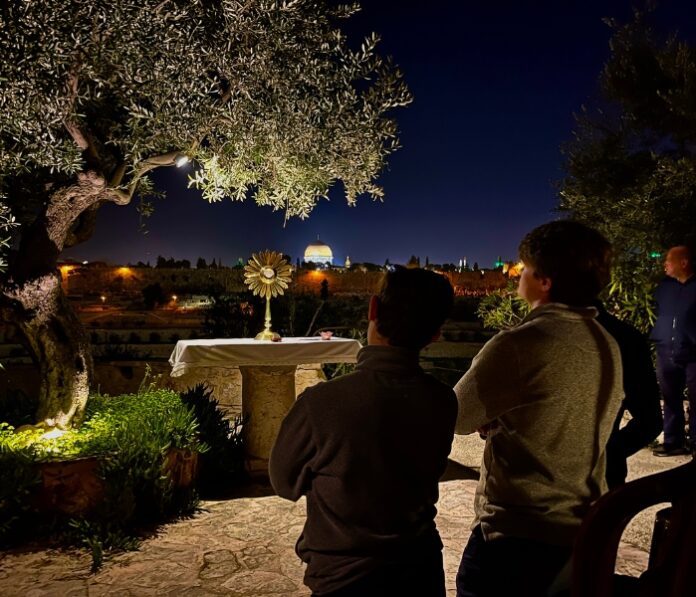Protests in Israel and Palestine prove both sides want peace
Protests in Israel and in the Gaza Strip flared up recently after a ceasefire established in Jan. 2025 was broken. In a brazen act of defiance, both Israelis and Palestinians took to the streets to call for peace and to protest their ruling authorities.
In Jerusalem, thousands of protesters gathered outside the Parliament building, calling for a renewed cease-fire deal in Gaza after IDF strikes killing more than four hundred, including children, ended the ceasefire.
While the Oct. 7 attacks united Israel under a common cause, the political and social disunity that rocked the country in the months before the attack have seemingly returned.
Polls from the Israel Democracy Institute suggest that 72% of Israelis believe that Prime Minister Benjamin Netanyahu should accept responsibility for Oct. 7 and resign either immediately or after the war.
Many Israelis believe Netanyahu did not do enough to protect Israelis from terrorism. Evidence obtained by the New York Times reveals Israeli officials had obtained documents of Hamas’s plans, with detailed outlines of the attack, a year before it happened. Officially, Israeli officials had dismissed it as “aspirational” and too difficult for Hamas to carry out.
Additionally, 73% of Israelis support Israel continuing with a second stage of negotiations that would include a complete cessation of hostilities, withdrawal from Gaza and release of Palestinian prisoners in exchange for the release of all the hostages.
A week later in Gaza, hundreds bravely defied Hamas, calling for them to step down, end the war and leave Palestine. Despite Hamas’s rule with an iron fist over Palestinians and history of cracking down on dissent through violence and detention, Palestinian suffering hit its boiling point, and its people were no longer afraid.
“Our demands are clear: End the war at any cost… We have absolutely nothing to lose. We have lost everything already, so we are not afraid,” said one protestor, according to the New York Times.
“We call on Hamas to stop this and leave us. We don’t know when this will end, but we want peace and democracy,” said another.
“We’re persecuted by both sides,” said a third. “Israel bombs us without mercy, and Hamas doesn’t care if we die.”
The protests seen on both sides of the conflict convey a hopeful message: peace is possible, and it is exactly what the people want.
As such, the average Israeli and Palestinian are able to separately share a common desire: they just want to live in peace. The resilience of innocent Palestinians and Israelis is a testament to that.
The protests in the last month further defeat harmful ideas that there are “no innocent Palestinians” or that all Israelis are responsible for violent settler colonialism–ideas that are not conducive to peace.
Can the Palestinian right to self-determination and the Israeli right to live free from terrorism be realized? It is possible. But that change can only happen when those in power become accountable to those they claim to be fighting for, or when they are ousted from that power.
This ought to be the time when the international world comes in, especially the United States, given the power it holds over Israel and Palestine. It should negotiate mutually beneficial treaties and apply pressure on the leaders of both groups where needed.
It would be naive, of course, to ignore the negative sentiments that Israelis and Palestinians retain toward each other. Support for a two-state solution on its own remains a minority view on both sides, according to the Palestinian Center for Policy and Survey Research.
Many citizens on both sides support annexation of the other with limited rights for their people, although that remains a minority view as well. Taken together, there is ultimately no prevailing majority opinion on what the future of the two peoples should look like.
Yet, when asked to choose between a larger war and a two-state peace solution, over 60% of Israelis and Palestinians prefer the latter as the alternative. This gives hope for serious change. To get a more detailed picture of the statistics, you may find it valuable to search up “The Palestine/Israel Pulse, a Joint Poll: Press Release” from the PCPSR.
Ultimately, peace is a fragile thing, and history has seen it break easily. But if there is one thing that can also be learned from history, it is that peace is also deeply cherished by the innocent people caught in conflict.
How this conflict will end is uncertain, but one should never lose sight of hope on behalf of the Israelis and Palestinians. Pray for peace.
Justin Yang is a freshman at UD.
